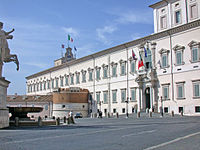Roman Republic
| ||||
| National Motto: Conventus Populusque Romanus – CPQR (Latin:Congress and the People of Rome) | ||||
| Click Here to view Click Here to view Click Here to view | ||||
| Founding - Founding of Rome - Establishment of the Republic - Establishment of the Imperium - Establishment of the Second Republic |
753 B.C. 509 B.C. 27 A.D. 1480 A.D. | |||
| Spoken Languages |
Hindi, Latin | |||
| Capital | Rome | |||
| Leader - President - Vice President |
Bhavan H. Patel | |||
| Population - Total (2005) |
4+ billion | |||
| Government Type | Congressional System | |||
| Nation Type | Federal Republic | |||
| National animal - Official |
Aquila | |||
| Currency | United States Dollar | |||
| Nationality | Roman, Hindustani | |||
| International Abbreviations | RR & USR | |||
| Naval Craft Classification - Roman Navy - Roman Merchant Navy |
USS USMS | |||
| National Anthem | Roman National Anthem | |||
| Internet TLD | .rr | |||
| Calling Code | +100 | |||
The United States of Rome, also known as the United States, U.S., Roman Republic and Rome is a country the spans throughout Europe, Middle East, and Southeast Asia. It extends from the Atlantic Ocean to the Indian Ocean. The United States is a Federal Republic, with it's capital located in Rome.
Contents
Name
The name Rome orginates from the greek word
Geography
History
Capital
</div>The Capital of the Roman Republic is Rome. Rome has been changed over the years after it's founding. The current President of Rome has kept the important ancient Roman buildings untouched because it reflects Rome's achievement in engineering.
Government and Politics
The modern government of the United States is set up the Constitution of the United States of Rome. Many people consider the the modern government to be successful to the First Republic.
The Government is split up into three branches in which they check and balance each other's power:
- Legislative: The Congress, made up of the House of Representatives and the Senate.
- Executive: The President, who appoints, with Senate approval, the Cabinet and other officers to help administer federal law.
- Judicial: The Supreme Court and lower federal courts
Foreign Relations
The United States has a signinficant amount of economic, political, and military influence throughout the world. Almost every country has an embassy in Rome and various consulates throughout the nation. Certain countries have no diplomatic relations.
Military
The United States has has a long tradition of military experience and civilian control of military affairs. The Ministry of Defense administers control over the United States Military, which comprises the Army, the Navy, the Marine Corps, and the Air Force. The Coast Guard is under the command of the Ministry of Fatherland Security, but in times of war it fall under the Navy. The total personnel is fifty million strong. Service is voluntary, but conscription may occur anytime through the Selective Service Program.
Administrative Divisions
The United States comprises of 126 states also known as the continental United States. The United States holds several territories.
Economy
Demographics
Largest Cities
Culture
Religion
The United States does not officialize one religion because of the law of speration of state and religion. Currently the major religion is Hinduism which comprises about sixty percent of the population. Behing it is Islam (20%), Judiasm (3%),Buddism (1.9)% Other (0.1%).
Language
The official language of the United States is Hindi. The secondary language is Latin. Many states utilize their indigenous language making it their state language.
Education
Education is handle by states and local cities, not federal. The Federal Goverment's Ministry of Education monitors and manages the education system to see if it's on course or needs improvement. At the State level, all students are require to attend school from Nursery to 12th grade. Parent many sign papers granting their children that they are not required to go to school. Parents may also educate their children at home but they are required to take a high school exam which certifies them as high school graduates.
Once a student graduates, they are given the option of attending the several universities located throughout the United States. Cuurently their are 230 universities both public and private. Public universities comprise a large body of students and a funded by the state and federal government, but students have to pay through a student loan or scholarship. Private universities comprise a small body of students and are not funded by the government, making the tution rate high. Around 30% of the population aged 25 and above have received their bachelor's degree.
The United States currently has an average literacy rate between 75% and 86%. The government and many literacy organizations are currently helping the population become literate.
 width=130px|
width=130px|

